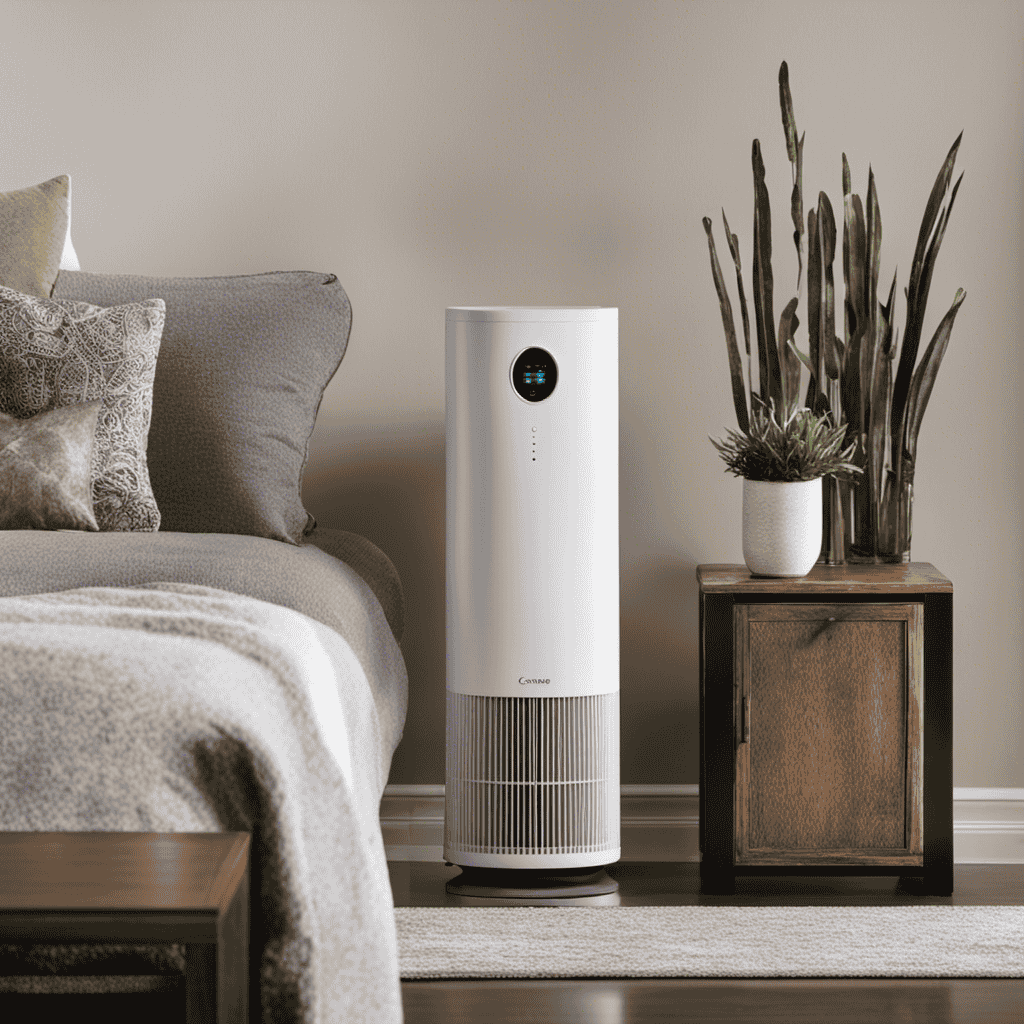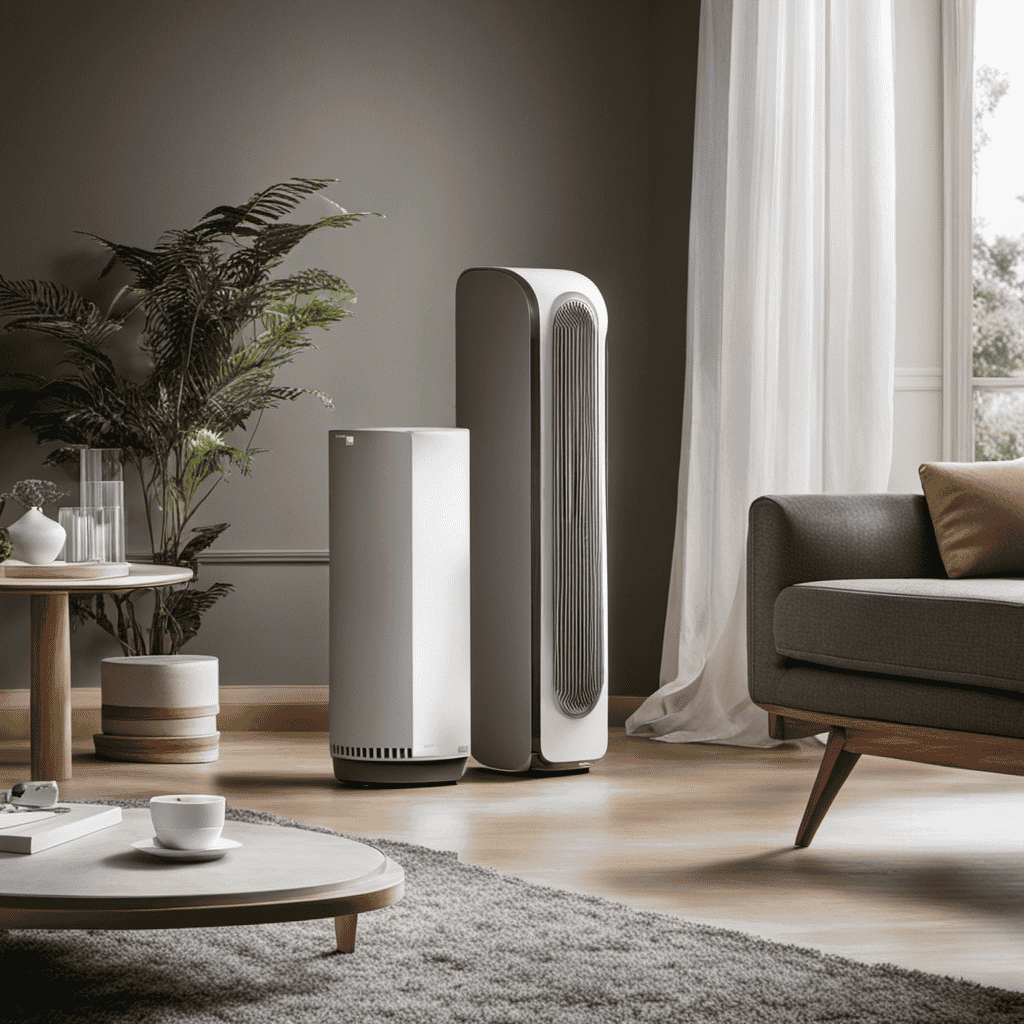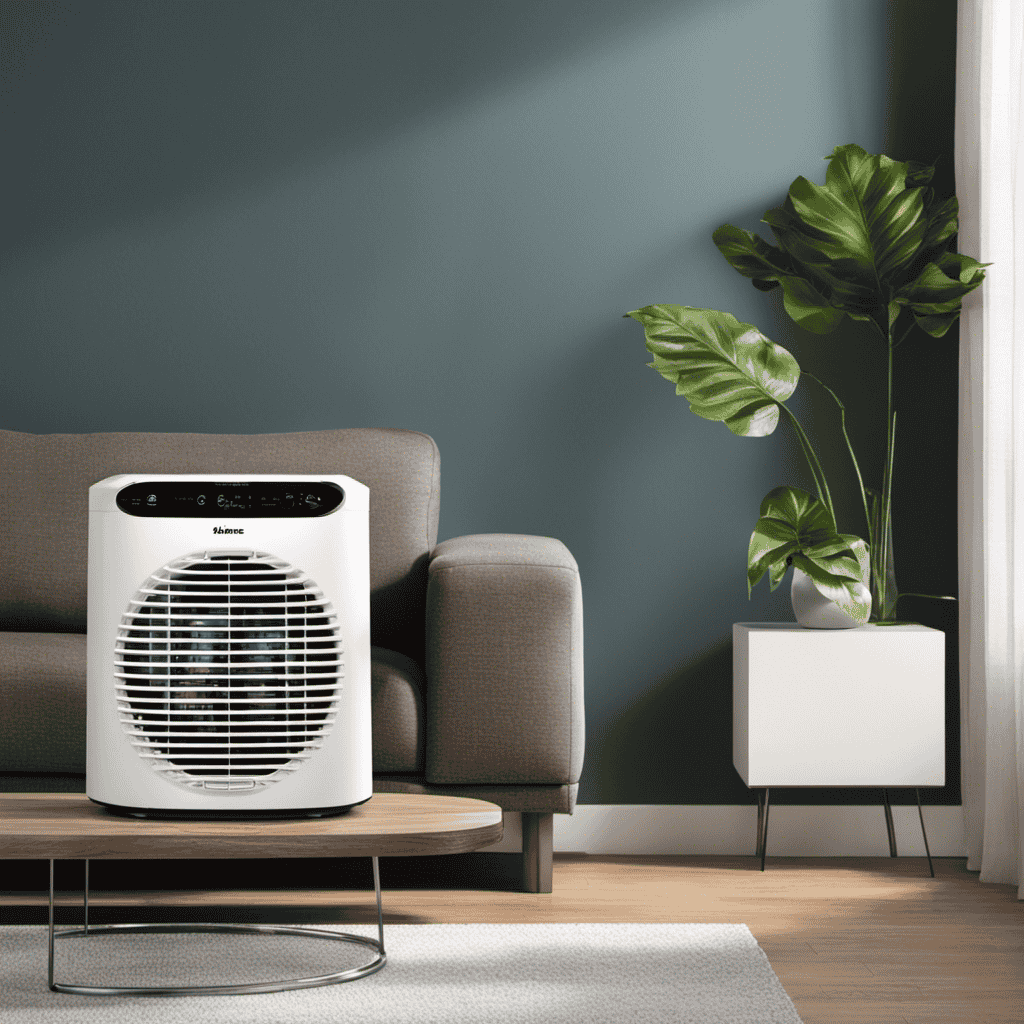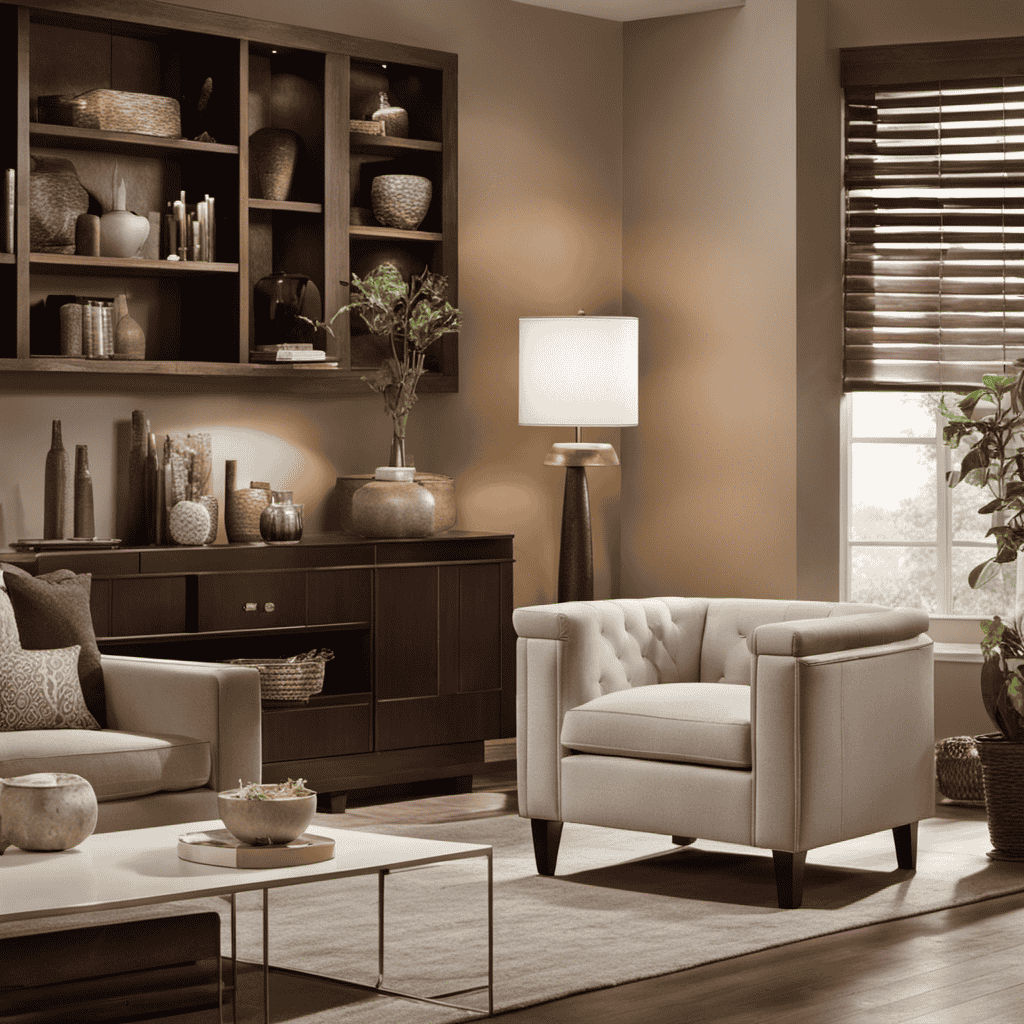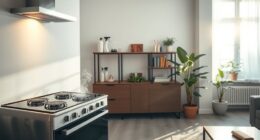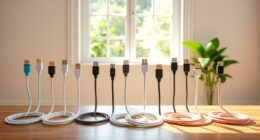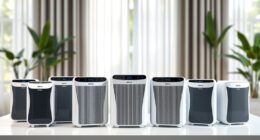How frequently should I replace my air purifier filter? This is a common question that is important for ensuring clean and healthy indoor air.
In this article, we will explore the factors that affect the lifespan of air purifier filters and understand the recommended frequency for filter changes. We will also discuss the signs that indicate it’s time to replace the filter and how to check its condition.
So, let’s dive in and discover the science behind air purifier filter maintenance.
Key Takeaways
- The frequency of changing an air purifier filter varies depending on factors such as air quality, usage, and manufacturer’s guidelines.
- It is recommended to change the filter every 6 to 12 months, but this can be extended by regularly cleaning the filter and using a pre-filter.
- Signs that indicate it’s time to change the filter include visible dust accumulation, decreased air flow, unpleasant odors, and increased allergy symptoms or respiratory issues.
- Regularly changing the air purifier filter has benefits such as improved air quality, extended lifespan of the purifier, reduced allergens, improved respiratory health, increased energy efficiency, and prevention of motor strain.
Factors Affecting Air Purifier Filter Lifespan
Depending on factors such as air quality and usage, you’ll need to change your air purifier filter more frequently or less frequently. The recommended filter change frequency is typically stated by the manufacturer, and it is important to follow these guidelines to ensure optimal performance of your air purifier.
Clean air is crucial for our health and well-being, as it can reduce the risk of respiratory illnesses, allergies, and asthma attacks. A clean air purifier filter helps to remove airborne particles such as dust, pollen, pet dander, and mold spores, providing us with the benefits of clean air.
Understanding the recommended filter change frequency is essential in maintaining a healthy indoor environment and maximizing the effectiveness of your air purifier. Transitioning into the next section, let’s explore the factors that influence the recommended filter change frequency in more detail.
Understanding the Recommended Filter Change Frequency
To understand how frequently you should replace the filter in your air purifier, it’s important to know the recommended filter change frequency. The lifespan of an air purifier filter is influenced by several factors, such as the type of filter used, the level of pollutants in the air, and the frequency of use.
Generally, most manufacturers recommend replacing the filter every 6 to 12 months. However, this can vary depending on the specific model and usage conditions. It’s crucial to follow the manufacturer’s guidelines and regularly check the filter for any signs of wear or clogging.
Additionally, to extend the lifespan of your air purifier filter, you can vacuum the filter periodically or consider using a pre-filter to capture larger particles. Understanding the recommended filter change frequency is essential for maintaining optimal air quality in your home.
With that in mind, let’s now discuss the signs that indicate it’s time to change the air purifier filter.
Signs That Indicate It’s Time to Change the Air Purifier Filter
When it comes to maintaining air purifiers, understanding the recommended filter change frequency and monitoring visible dust accumulation are crucial.
Knowing how often to replace the filters ensures optimal performance and clean air quality.
Additionally, keeping an eye on visible dust accumulation provides tangible evidence of the air purifier’s effectiveness in capturing airborne particles.
Filter Replacement Frequency
The frequency of replacing an air purifier filter depends on the quality of air in your home. Several factors can influence the longevity of the filter. These factors include the size of your home, the number of occupants, the presence of pets, and the level of air pollution in your area.
Regular maintenance is essential to ensure optimal performance and prolong the lifespan of the filter. By regularly replacing the filter, you can benefit from cleaner air, reduced allergens, and improved respiratory health. Neglecting filter maintenance can lead to reduced efficiency and increased energy consumption.
It is important to follow the manufacturer’s recommendations for filter replacement to maintain the effectiveness of your air purifier. Now, let’s explore another factor that indicates the need for filter replacement: visible dust accumulation.
Visible Dust Accumulation?
Visible dust accumulation on the air purifier filter indicates that it needs to be replaced. Checking filters regularly is crucial to maintain the efficiency of an air purifier.
Dust accumulation can affect the performance of the filter and reduce its ability to capture airborne particles effectively. Studies have shown that a dirty filter can decrease the clean air delivery rate (CADR) by up to 25%. This means that the air purifier will be less effective at removing pollutants from the air, potentially leading to poor indoor air quality.
It is recommended to check the filter every two to three months, or more frequently in areas with high levels of dust or pollution. By monitoring dust accumulation and replacing filters as needed, you can ensure that your air purifier continues to provide clean and healthy air.
How to Check the Condition of Your Air Purifier Filter
To check if your air purifier filter needs changing, simply remove the filter and inspect it for any visible signs of dirt or blockage. It’s important to regularly check the condition of your air purifier filter to ensure optimal performance. There are several methods to determine if your filter needs to be replaced. One way is to visually inspect the filter for accumulated dust, debris, or discoloration. Another method is to measure the airflow coming out of the air purifier. If the airflow is significantly reduced, it may indicate a clogged filter. Additionally, some air purifiers have a filter change indicator that alerts you when it’s time to replace the filter. The lifespan of an air purifier filter depends on various factors such as the quality of the filter, the level of pollutants in your environment, and the usage time. It is recommended to consult the manufacturer’s instructions for specific guidelines on filter replacement intervals.
| Checking Methods | Filter Lifespan Factors |
|---|---|
| Visual inspection | Filter quality |
| Airflow measurement | Pollutant levels |
| Filter change indicator | Usage time |
Common Misconceptions About Air Purifier Filter Lifespan
One common misconception is that air purifier filters need to be replaced frequently. However, this is not entirely accurate.
Many people believe that air purifier filters should be changed every month or even more frequently, but this is based on outdated information and misunderstandings.
In reality, the lifespan of an air purifier filter depends on various factors, such as the quality of the filter, the air quality in your environment, and how often the purifier is used.
High-quality filters can last anywhere from 6 to 12 months, while lower-quality filters may need to be replaced more often.
It is important to consult the manufacturer’s recommendations for your specific model to determine the appropriate lifespan of your air purifier filter.
The Role of Air Quality in Determining Filter Replacement Frequency
The lifespan of an air purifier filter depends on factors such as the quality of the filter and how frequently it is used. However, a key determinant is the air quality in your environment.
Air quality indicators, such as particulate matter (PM) levels, volatile organic compounds (VOCs), and allergens, can have a significant impact on filter efficiency. High levels of these pollutants can lead to faster clogging and reduced effectiveness of the filter, necessitating more frequent replacements.
For example, in areas with high levels of PM2.5, which are tiny particles suspended in the air, filters may need to be replaced more often to maintain optimal performance.
Monitoring air quality regularly and replacing filters accordingly can ensure that your air purifier continues to provide clean and healthy air for you and your family.
Different Types of Air Purifier Filters and Their Lifespan
Different types of air purifier filters have varying lifespans depending on factors like the quality of the filter and how frequently it is used. Understanding filter efficiency is crucial when comparing filter types.
HEPA (High-Efficiency Particulate Air) filters, for example, are known for their high efficiency in capturing airborne particles as small as 0.3 microns. These filters typically last between 6 to 12 months, depending on usage and environmental conditions.
On the other hand, activated carbon filters are effective in removing odors and harmful gases, but their lifespan is shorter, usually lasting around 3 to 6 months.
Additionally, washable filters offer a cost-effective option as they can be reused multiple times, but they may have a shorter lifespan compared to other filter types.
Understanding the lifespan of different filter types is important in order to properly maintain your air purifier and ensure optimal air quality in your home.
How to Properly Maintain Your Air Purifier Filter
When it comes to maintaining an air purifier filter, it’s important to understand the frequency at which it needs to be replaced.
This discussion will delve into the data-driven recommendations for filter replacement frequency, as well as provide thorough cleaning techniques and tips to ensure optimal performance.
Filter Replacement Frequency
You should check how often to change the air purifier filter. The frequency of filter replacement depends on several factors that can affect its lifespan. These factors include the air quality in your home, the size of the room, the number of people living in the space, and the presence of pets or smokers.
Regularly changing the air purifier filter has numerous benefits. First, it ensures that the air purifier functions optimally by maintaining its efficiency. A clean filter traps more airborne particles, such as dust, pollen, and pet dander, which improves the air quality in your home. Additionally, regular filter changes help prevent the accumulation of bacteria and mold, promoting a healthier living environment.
Overall, staying on top of filter replacements is crucial for maintaining clean and fresh indoor air.
Cleaning Techniques and Tips
To effectively clean your air purifier, start by unplugging it and removing the filter. Cleaning your air purifier regularly is crucial for its optimal performance and longevity. Here are four cleaning techniques and tips to ensure your air purifier stays in top condition:
-
Vacuum the exterior: Use a soft brush attachment to gently remove dust and debris from the outer surface of the air purifier. This prevents dirt from accumulating and affecting the air flow.
-
Wipe the casing: Use a damp cloth to wipe the casing of the air purifier. This helps remove any smudges or stains and keeps the unit looking clean and well-maintained.
-
Clean the filter: Follow the manufacturer’s instructions to clean the filter properly. This may involve rinsing it with water or using a vacuum cleaner to remove trapped particles. Regular filter maintenance is essential for optimal air purification.
-
Check the vents: Inspect and clean the vents of the air purifier to ensure proper air circulation. Blocked vents can reduce the effectiveness of the unit.
By following these cleaning techniques and tips, you can ensure that your air purifier remains in top condition and functions efficiently.
Now, let’s explore strategies to extend the lifespan of your air purifier filter.
Strategies to Extend the Lifespan of Your Air Purifier Filter
One way to extend the lifespan of your air purifier filter is by regularly cleaning it. Cleaning the filter helps to remove accumulated dust, debris, and particles, allowing it to continue functioning effectively.
In addition to regular cleaning, there are other strategies you can employ to maximize filter longevity. First, consider the location of your air purifier. Placing it in an area with minimal dust and pollutants can reduce the workload on the filter.
Second, avoid running your air purifier 24/7. Turning it off when not needed can help prolong the filter’s lifespan.
Lastly, following the manufacturer’s maintenance tips and guidelines is crucial. This may include replacing the filter when necessary or using a pre-filter to catch larger particles before they reach the main filter.
Benefits of Regularly Changing Your Air Purifier Filter
Regularly changing your air purifier filter has several key benefits that are supported by scientific data.
First, it improves air quality by effectively removing pollutants such as dust, allergens, and pet dander. This leads to a healthier indoor environment and can significantly reduce the risk of respiratory issues.
Second, it extends the lifespan of your air purifier by preventing clogs and ensuring optimal performance.
Improved Air Quality
You’ll notice a significant improvement in your air quality after changing the air purifier filter. Regularly replacing the filter is essential for maintaining the effectiveness of your air purifier and ensuring that it continues to provide the benefits it promises.
Here are four reasons why changing your air purifier filter is crucial for air pollution control:
-
Reduced allergens: A clean filter traps and removes airborne allergens such as pollen, dust mites, and pet dander, leading to a significant decrease in allergy symptoms.
-
Improved respiratory health: By capturing and removing harmful particles like smoke, mold spores, and bacteria, a fresh filter helps prevent respiratory issues and improves overall lung function.
-
Odor elimination: Changing the filter regularly eliminates unpleasant odors caused by cooking, pets, or chemical pollutants, creating a fresher and more pleasant-smelling indoor environment.
-
Increased energy efficiency: A clogged filter forces the air purifier to work harder, consuming more energy. By replacing the filter, you improve the unit’s efficiency, saving on energy costs while maintaining optimal performance.
Extended Appliance Lifespan
By replacing the filter, you can extend the lifespan of your air purifier. Regular maintenance and implementing strategies for filter longevity are crucial for maximizing the benefits of your air purifier.
The lifespan of an air purifier filter can vary depending on factors such as the quality of the filter and the air quality in your environment. However, it is generally recommended to replace the filter every 6 to 12 months. Regularly cleaning and vacuuming the filter can also help prolong its lifespan.
Investing in high-quality filters and following the manufacturer’s instructions for maintenance can significantly extend the lifespan of your air purifier. Regular maintenance not only ensures optimal performance but also improves indoor air quality and reduces the risk of allergens and pollutants circulating in your home.
Health Benefits Realized
To maximize the health benefits of your air purifier, it’s important to understand how it works and how it can improve the air quality in your home. Here are four factors to consider when it comes to air purifier maintenance and filter lifespan:
-
Regular cleaning: Dust and debris can accumulate on the surface of the filter, reducing its efficiency. Cleaning the filter regularly will help maintain its effectiveness in removing pollutants from the air.
-
Environmental conditions: The air quality in your area can affect the lifespan of your filter. If you live in a highly polluted area or near a construction site, your filter may get clogged faster and require more frequent replacement.
-
Pet ownership: If you have pets at home, their fur and dander can quickly fill up the filter. It’s essential to monitor the filter and replace it more frequently to ensure optimal air purification.
-
Filter quality: The type of filter you choose also plays a significant role in its lifespan. High-quality filters tend to last longer and provide better air purification.
How to Choose the Right Replacement Filter for Your Air Purifier
When selecting a replacement filter for your air purifier, it’s important to consider the specific model and its compatibility. Choosing the right replacement filter is crucial for maintaining optimal air quality in your home or office.
Proper maintenance techniques not only ensure the longevity of your air purifier but also contribute to its effectiveness in removing airborne pollutants. To choose the right replacement filter, start by identifying the make and model of your air purifier. This information will help you find the compatible filter that fits perfectly into your unit.
Additionally, consider the type of pollutants you want to target, such as dust, pollen, pet dander, or smoke. Different filters are designed to capture specific particles, so selecting the appropriate filter will enhance the performance of your air purifier.
Understanding the Impact of Filter Maintenance on Air Purifier Performance
When it comes to maintaining optimal air purifier performance, understanding the impact of filter maintenance is crucial.
Key points to consider include the lifespan and effectiveness of the filters, as well as the frequency of replacement.
Filter Lifespan and Effectiveness
The lifespan of an air purifier filter can vary depending on its effectiveness. Regular maintenance is crucial to ensure optimal performance and longevity.
Here are four factors that influence the lifespan of an air purifier filter and highlight the importance of regular maintenance:
-
Air quality: Filters in heavily polluted environments may require more frequent changes due to higher levels of contaminants.
-
Filter type: Different filter materials have varying lifespans. HEPA filters, for example, can last up to a year, while activated carbon filters may need replacement every few months.
-
Filter usage: Filters that run continuously or in high traffic areas may accumulate more particles quickly, reducing their lifespan.
-
Maintenance routine: Regular cleaning and replacement of filters according to the manufacturer’s recommendations can significantly extend their lifespan and maintain optimal air purification efficiency.
Frequency of Filter Replacement
To ensure optimum performance, regularly replacing your air purifier filter is essential. The frequency at which you should replace your filter depends on several factors.
Firstly, the manufacturer’s recommendation is a crucial factor to consider. Different brands and models may have varying guidelines on filter replacement.
Additionally, the air quality in your environment plays a significant role. If you live in a highly polluted area or have pets, you may need to replace the filter more frequently.
Regular maintenance brings several benefits. By changing the filter regularly, you ensure that it can effectively capture and remove pollutants, allergens, and other particles from the air. This helps to maintain clean and healthy indoor air quality, reducing the risk of respiratory issues and allergies.
Furthermore, a clean filter allows the air purifier to operate at its best, maximizing its performance and energy efficiency.
Improving Air Quality
If you want to improve your indoor air quality, consider using houseplants as natural air purifiers. Not only do they add beauty to your space, but they also have numerous benefits for your health.
Here are four reasons why having houseplants can greatly contribute to improving indoor air and reaping the benefits of clean air:
-
Natural filtration: Houseplants are known for their ability to absorb harmful pollutants such as formaldehyde, benzene, and trichloroethylene from the air. This natural filtration process helps to remove toxins and improve the overall air quality in your home.
-
Increased oxygen levels: Through the process of photosynthesis, houseplants release oxygen into the air, increasing the oxygen levels in your indoor environment. This can lead to better respiratory health and increased energy levels.
-
Humidity regulation: Some houseplants, like peace lilies and spider plants, help to regulate humidity levels by releasing moisture into the air. This can alleviate dryness and reduce the risk of respiratory issues caused by dry air.
-
Stress reduction: Studies have shown that being around nature and plants can have a calming effect on the mind and body, reducing stress levels and promoting overall well-being.
Environmental Factors That Affect Filter Replacement Frequency
Depending on where I live and the air quality in my area, factors like pollution and allergens can impact how often I should change my air purifier filter.
Several factors can affect the efficiency of the filter and the lifespan of the filter.
One of the main factors is air pollution. The higher the levels of air pollution in the area, the more frequently the filter will need to be replaced. This is because the filter will be constantly exposed to a higher concentration of pollutants, which can clog the filter and reduce its efficiency.
Additionally, the presence of allergens such as pollen, dust, and pet dander can also impact the lifespan of the filter. These particles can accumulate on the filter, further reducing its effectiveness.
Therefore, it is important to consider these environmental factors when determining how often to change the air purifier filter.
The Importance of Following Manufacturer’s Recommendations for Filter Changes
Make sure you follow the manufacturer’s recommendations for when to replace your filter to ensure optimal performance. Neglecting to replace your air purifier filter at the recommended intervals can significantly affect its efficiency.
Here are four common mistakes in filter maintenance that can compromise its effectiveness:
-
Delaying filter replacement: Waiting too long to change your filter can result in reduced air quality and increased allergen levels in your home, potentially causing health issues.
-
Not cleaning or replacing pre-filters: Over time, pre-filters become clogged with larger particles, reducing their efficiency and compromising the overall effectiveness of the air purifier.
-
Improper filter installation: Failing to install the filter correctly can lead to air leakage, rendering the purifier ineffective in capturing pollutants.
-
Using non-genuine filters: Using counterfeit or off-brand filters may not fit properly, reducing their efficiency and potentially damaging the air purifier.
Frequently Asked Questions About Air Purifier Filter Replacement
When should you replace your air purifier filter to ensure optimal performance?
Understanding filter efficiency is crucial in determining the frequency of filter replacement. Air purifier filters are designed to capture and remove airborne particles, such as dust, pollen, and pet dander, from the air. Over time, these filters can become clogged with these particles, reducing their effectiveness.
To maintain optimal performance, it is recommended to replace your air purifier filter every 6 to 12 months, depending on usage and the manufacturer’s recommendations. Regularly replacing your filter not only ensures cleaner air but also prolongs the lifespan of your air purifier.
Additionally, considering cost-effective options, such as washable or reusable filters, can help reduce long-term expenses associated with filter replacement. By understanding filter efficiency and choosing the right replacement option, you can ensure that your air purifier continues to provide clean and healthy air.
What Are the Signs That Indicate It’s Time to Change an Air Purifier Filter?
If you notice a decrease in air quality, increased allergy symptoms, or decreased airflow, it may be time for an air purifier filter change. The air purifier filter change frequency will vary depending on usage and the environment, but paying attention to these signs can indicate when it’s time for a replacement.
Frequently Asked Questions
Can I Clean and Reuse My Air Purifier Filter Instead of Replacing It?
Cleaning and reusing an air purifier filter is not recommended. Regularly replacing filters ensures optimal performance and removes pollutants effectively. It also prevents the accumulation of dirt and allergens, promoting cleaner air quality.
Will Using a Higher Quality Air Purifier Filter Make It Last Longer?
Using a higher quality air purifier filter can extend its lifespan. It improves air purifier performance, captures more pollutants, and requires less frequent replacement. Regular air purifier filter maintenance is essential for optimal performance.
How Often Should I Clean the Exterior of My Air Purifier?
I clean the exterior of my air purifier every 2-3 weeks to remove dust and maintain its efficiency. I use a soft cloth and mild detergent, making sure to avoid getting water inside the unit.
Can I Use My Air Purifier Without a Filter?
I can’t imagine using an air purifier without a filter! It’s like trying to catch a baseball with a tennis racket. Cleaning methods are important, but there aren’t any good alternative options to a filter.
Are There Any Health Risks Associated With Not Changing the Air Purifier Filter Regularly?
Not changing air purifier filters regularly can pose health risks due to the accumulation of pollutants. Regularly changing filters ensures optimal air quality by removing harmful particles and allergens, promoting a healthier living environment.
Conclusion
In conclusion, as I reflect on the importance of regularly changing air purifier filters, I am reminded of the ancient Greek myth of Prometheus. Just as Prometheus brought the gift of fire to humanity, air purifiers bring the gift of clean, purified air.
But without proper filter maintenance, this gift becomes tainted and ineffective. By following the manufacturer’s recommendations and understanding the impact of environmental factors, we can ensure that our air purifiers continue to provide us with the pure air we deserve.
Let us not neglect this vital task and embrace the power of clean air.
